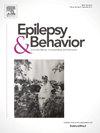Role of specific interictal and ictal EEG onset patterns
IF 2.3
3区 医学
Q2 BEHAVIORAL SCIENCES
引用次数: 0
Abstract
The objective of this review is to present the role of specific interictal and ictal EEG onset patterns during scalp video-EEG monitoring. Specific non-epileptiform abnormalities include temporal intermittent rhythmic delta activity (TIRDA) and temporal intermittent rhythmic theta activity (TIRTA) indicating a temporal lobe seizure onset, while interictal rhythmical midline theta activity occurs more frequently in frontal epilepsy. Specific interictal epileptiform abnormalities comprise Type 1 spikes pointing towards a mesial and Type 2 spikes indicating a lateral temporal irritative zone. Unilateral temporal interictal epileptiform discharges (IEDs) are predictive for a good surgical seizure outcome in temporal lobe epilepsy. Small sharp spikes (SSS) named Benign Epileptiform Transients of Sleep (BETS) in the past represent scalp EEG markers of hippocampal epileptic activity. While the localizing value of IEDs in extratemporal epilepsies is often limited, a consistently localized spike focus predicts a good surgical seizure outcome in non-lesional extratemporal patients. A specific ictal EEG pattern for mesial temporal lobe epilepsy consists of a 5–9 Hz rhythmic temporal activity which also predicts a good surgical outcome. In extratemporal epilepsies, ictal scalp EEG frequently is non-localized. Concerning the correspondence of ictal scalp-EEG and intracranial EEG (iEEG) patterns there is no simple one-to-one relationship. Scalp-EEG and iEEG patterns correspond closer to each other when there is no delay between clinical and scalp-EEG onset. Paroxysmal fast activity on scalp-EEG matches with low-voltage fast activity on iEEG. Repetitive epileptiform discharges on scalp EEG indicate an underlying focal cortical dysplasia.
求助全文
约1分钟内获得全文
求助全文
来源期刊

Epilepsy & Behavior
医学-行为科学
CiteScore
5.40
自引率
15.40%
发文量
385
审稿时长
43 days
期刊介绍:
Epilepsy & Behavior is the fastest-growing international journal uniquely devoted to the rapid dissemination of the most current information available on the behavioral aspects of seizures and epilepsy.
Epilepsy & Behavior presents original peer-reviewed articles based on laboratory and clinical research. Topics are drawn from a variety of fields, including clinical neurology, neurosurgery, neuropsychiatry, neuropsychology, neurophysiology, neuropharmacology, and neuroimaging.
From September 2012 Epilepsy & Behavior stopped accepting Case Reports for publication in the journal. From this date authors who submit to Epilepsy & Behavior will be offered a transfer or asked to resubmit their Case Reports to its new sister journal, Epilepsy & Behavior Case Reports.
 求助内容:
求助内容: 应助结果提醒方式:
应助结果提醒方式:


